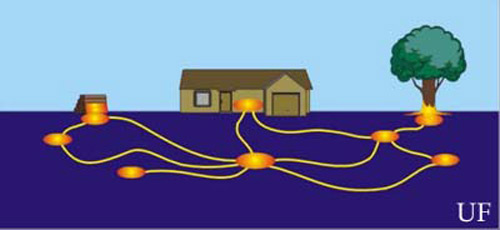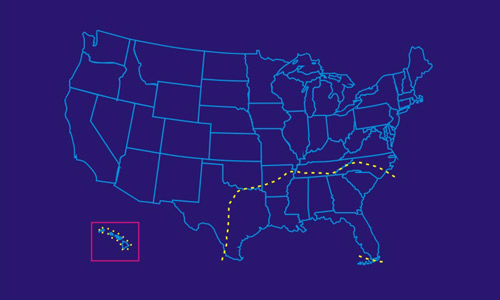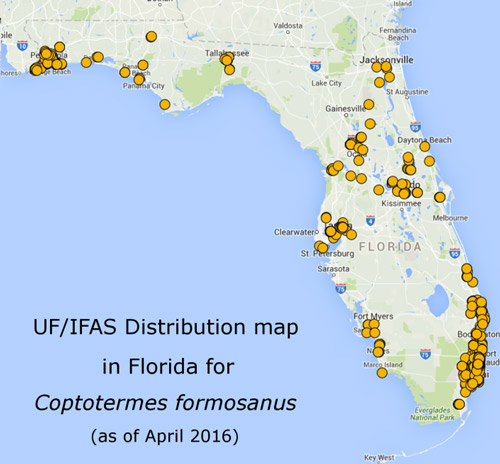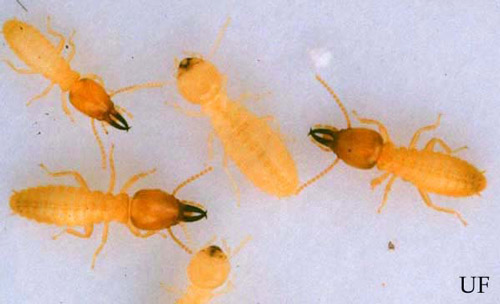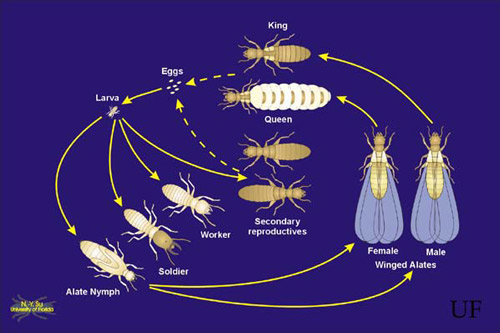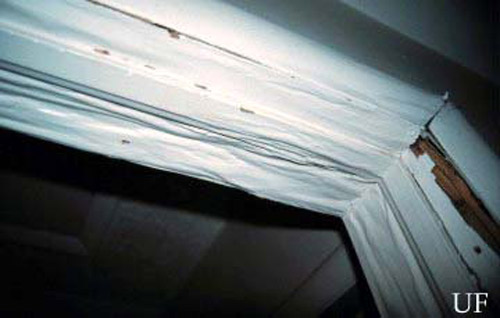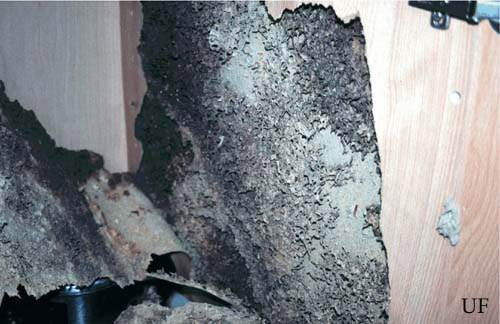common name: Formosan subterranean termite
scientific name: Coptotermes formosanus Shiraki (Insecta: Blattodea: Rhinotermitidae)
Introduction - Distribution - Description and Identification - Life History - Damage - Pest Status - Management - Selected References
Introduction (Back to Top)
The genus Coptotermes contains the largest number of termite pests (28 species) among the >3,100 termite species worldwide, and the Formosan subterranean termite, Coptotermes formosanus, is the most widely distributed and most economically important. The Formosan subterranean termite acquired its name because it was first described in Taiwan in the early 1900s, but Coptotermes formosanus is probably endemic to Taiwan and southern China. This destructive species was apparently transported to Japan prior to the 1600s and to Hawaii in the late 1800s (Su and Tamashiro 1987). By the 1950s, it was reported in South Africa. During the 1960s it was found in Texas, Louisiana, and South Carolina. In 1980, a well-established colony was thriving in a condominium in Hallandale, Florida. A single colony of Formosan subterranean termite may contain several million termites (versus several hundred thousand termites for native subterranean termite species) that forage up to 300 ft in soil (Figure 1). Because of its population size and foraging range, the presence of Formosan subterranean termite colonies poses serious threats to nearby structures. Once established, Formosan subterranean termite has never been eradicated from an area.
Figure 1. A single colony of the Formosan subterranean termite, Coptotermes formosanus Shiraki, may contain several million individuals that forage up to 300 ft in soil. Graphic by Nan-Yao Su, University of Florida.
Distribution (Back to Top)
As of 2019, the distribution of Formosan subterranean termite in the United States includes Alabama, Florida, Georgia, Hawaii, Louisiana, Mississippi, North and South Carolina, Tennessee, and Texas (Figure 2).
Figure 2. Known distribution (between dotted yellow lines) of the Formosan subterranean termite, Coptotermes formosanus Shiraki, in the United States, as of 2016. Graphic by Nan-Yao Su, University of Florida.
The Formosan subterranean termite was first reported in Florida in early 1980s in Hallandale, Broward County. But it was probably introduced there at least five to 10 years previously. As of 2019, Formosan subterranean termite is found in almost all major urban areas of Florida (Figure 3). In urban southeastern Florida where the Formosan subterranean termite was first found, its distribution has expanded to include much of the costal areas of Dade, Broward, and Palm Beach Counties. Click this link for the most recent update of Formosan subterranean termite distribution in Florida.
Figure 3. Known distribution of the Formosan subterranean termite, Coptotermes formosanus Shiraki, in Florida, as of 2019. Figure by Thomas Chouvenc, University of Florida.
Description and Identification (Back to Top)
As its name indicates, the Formosan subterranean termite is a subterranean termite species characterized by large populations that share interconnected foraging galleries in soil. When these termites invade a house above-ground, foraging tubes of ca. 0.25 to 0.5 inch diameter may be found connecting soil and the infested house (Figure 4).

Figure 4. Foraging tubes of the Formosan subterranean termite, Coptotermes formosanus Shiraki. Photograph by Nan-Yao Su, University of Florida.
As with other termite species, colonies of Formosan subterranean termite contain three primary castes: the reproductives (e.g. king, queen, alates or swarmers, and immature alates or nymphs), soldiers, and workers. The majority of the nestmates are workers that are responsible for acquisition of nutrients, i.e. cellulose in wood. Alates and soldiers are most useful for identification (Scheffrahn and Su 1994).
Alates of Formosan subterranean termite are yellowish-brown and 12 to 15 mm long (0.5 to 0.6 inch). There are numerous small hairs on the wings of these comparatively large swarmers. Dispersal flights or "swarms" are massive and begin at dusk on calm and humid evenings from April to July. Alates are attracted to lights, so they are usually found near windows, light fixtures, window sills, and spider webs around well lighted areas (Figure 5).
Figure 5. Small hairs on wings of swarmers of the Formosan subterranean termite, Coptotermes formosanus Shiraki. Photograph by Rudolf H. Scheffrahn, University of Florida.
Soldiers of Formosan subterranean termite have an orange-brown, oval-shaped head, curved mandibles and a whitish body (Figure 6). When disturbed, soldiers readily attack any approaching objects, and may secrete a white gluey fluid (called defensive secretion) from a large opening (called fontanel) in the head. There are more soldiers (10 to 15%) in a Formosan subterranean termite colony than that of the native subterranean species in Florida (1 to 2%). Because the Formosan subterranean termite colony contains a larger soldier proportion than native subterranean termites, infestations with many soldiers is a clue to its presence.
Figure 6. Soldiers (orange-brown, oval-shaped head) and workers of the Formosan subterranean termite, Coptotermes formosanus Shiraki. Photograph by Nan-Yao Su, University of Florida.
Life History (Back to Top)
A single colony of Coptotermes formosanus may produce over 70,000 alates. After a brief flight, alates shed their wings. Females immediately search for nesting sites with males following closely behind. When the pair finds a moist crevice with wooden materials, they form the royal chamber and lay approximately 15 to 30 eggs. Within two to four weeks, young termites hatched from the eggs. The reproductives nurse the first group of young termites until they reach third instar (Figure 7). One to two months later, the queen lays the second batch eggs which would be eventually nursed by termites from the first egg batch. It may take three to five years before a colony reach substantial number to cause severe damage and produce alates.
Figure 7. Life cycle of the Formosan subterranean termite, Coptotermes formosanus Shiraki. Graphic by Nan-Yao Su, University of Florida.
Damage (Back to Top)
A single individual of the Formosan subterranean termite does not consume more wood than a single native subterranean termite, however, because of its large population size, a Formosan subterranean termite colony can cause more structural damage in a shorter time. Wood products that are infested by Formosan subterranean termite may be recognized by tapping the wood with a hard object. In severe infestations, Formosan subterranean termite hollows out woods leaving a paper-thin surface. A hollowed wood surface may look blistered or peeled (Figure 8).
Figure 8. Blistered wood surface damage caused by the Formosan subterranean termite, Coptotermes formosanus Shiraki. Photograph by Nan-Yao Su, University of Florida.
Another characteristic of Formosan subterranean termite is carton nest material that is made of termite excrements, chewed wood, and soil. Carton nests (Figure 9) are usually found in structure voids such as between walls and beneath sinks.
Figure 9. Carton nest of the Formosan subterranean termite, Coptotermes formosanus Shiraki. Photograph by Nan-Yao Su, University of Florida.
The Formosan subterranean termite generally invades structures from the ground. They commonly enter through expansion joints, cracks and utility conduits in slabs. Any wood-to-ground contact is an inviting entrance for Formosan subterranean termite infestations. In some occasions, however, Formosan subterranean termite can form colonies that are not connected to ground, called aerial colonies. If a pair of alates successfully finds suitable conditions, i.e., adequate food and moisture sources in a building, they can initiate a colony with no ground connection. The flat roofs of high-rise buildings, because they always pool rainwater, are ideal places for the Formosan subterranean termite to initiate aerial infestations if portals of entry are found. Our survey data indicated that more than 25% of the infestations found in the urban southeastern Florida are caused by aerial colonies (Su and Scheffrahn 1987).
Studies also found that Formosan subterranean termite attack many species of living plants. The Formosan subterranean termite attacks structural lumbers and living plants because they are sources of cellulose. However, this termite is also known to attack non-cellulose materials such as plaster, plastic, asphalt, and thin sheets of soft metal (lead or copper) in search of food and moisture. Their highly publicized ability to penetrate solid concrete is a fallacy. However, the Formosan subterranean termite is persistent in finding small cracks in concrete which they enlarge and use as foraging routes.
Pest Status (Back to Top)
Although their distribution in the United States is more restricted than other subterranean termites such as Reticulitermes species, Coptotermes formosanus can cause substantial economic loss in infested areas. In the city of New Orleans where this termite species was introduced in the 1950's, the control and repair costs due to Formosan subterranean termite is estimated at $300 million annually (Suszkiw 1998). It is considered the single most economically important insect pest in the state of Hawaii. As the populations grow, economic loss caused by this termite species in more recently established areas will approach the pest status experienced in New Orleans and Hawaii.
Management (Back to Top)
Preventive practice: Wood pressure-treated with preservatives (creosote, pentachlorophenol, inorganic salts such as alkaline copper quaternary or ACQ, etc.) are required by building codes for use at the point of wood-soil interface; primarily to prevent fungi decay. The Formosan subterranean termite does not damage pressure-treated wood but is capable of by-passing the treated wood to infest untreated wood in structures. The combination of water and wood or other cellulose materials provide attractive conditions for the Formosan subterranean termite. Leaky plumbing, air conditioning condensate, and any portion of the building that may collect excessive amounts of moisture should be corrected to maintain an environment less attractive to Formosan subterranean termite.
Soil treatment: The conventional method for control of subterranean termites, including the Formosan subterranean termite is to place a chemical barrier between termites and the structure to be protected. Currently available (as of January 2019) termiticides include: permethrin (Dragnet® FT, etc.), cypermethrin (Demon® TC, etc.), bifenthrin (Biflex® FT, etc.), imidachloprid (Premise®, etc.) chlorfenapyr (Phantom®), chlorantraniliprole (Altriset®), and fipronil (Termidor®, etc.). Pyrethroids such as permethrin, cypermethrin, bifenthrin and fenvalerate repel termites from treatment barriers, while other termiticides prevent termite invasion by lethal contact. For preconstruction treatment, soil termiticides are applied onto sub-slab soil before the foundation is poured. Post-construction treatment can be done by drilling holes through slabs and injecting insecticides under foundation and by drenching trenches dug in soil along building foundations.
Population control using baits: Because of the large size of a Formosan subterranean termite colony, application of soil termiticides beneath a structure usually do not impact the overall population of several million termites that inhabit galleries extending up to 300 ft. Laboratory studies showed that soil termiticides may kill some termites but most termites in the colony would survive. They would avoid treated soil and may re-invade the house (Su 2005, Chouvenc 2018). Termite baits were developed to address the shortcomings of soil termiticide treatments, especially when facing the Formosan subterranean termite colonies with large population sizes (Su 2019). One such bait product, the Sentricon® Termite Colony Elimination System uses a durable bait, Recruit® HD that contains a chitin synthesis inhibitor (CSI), noviflumuron. CSIs do not kill termites immediately after bait consumption. Instead they disrupt termite molting, which occurs approximately every 45 days. When placed in the stations, termites continue to feed on CSI baits (Figure 10A) and transfer the baits to other member of the colony. The feeding continue until baited termites are ready to molt and killed due to a disruptive molting. By then most of the colony member have received lethal doses of CSIs, leading to the collapse of the colony (Figure 10B).
Figure 10. Termites feed on CSI baits and transfer the baits to other member of the colony (A) until most of the colony member receive lethal doses of CSIs, resulting in the collapse of the colony (B).
Selected References (Back to Top)
- Chouvenc T. 2018. Comparative impact of chitin synthesis inhibitor baits and non-repellent liquid termiticides on subterranean termite colonies over foraging distances: colony elimination versus localized termite exclusion. Journal of Economic Entomology 111: 2317-2328. https://doi.org/10.1093/jee/toy210
- Grace JK, Tome CHM, Shelton TG, Oshiro RJ. 1996. Baiting studies and considerations with Coptotermes formosanus (Isoptera: Rhinotermitidae) in Hawaii. Sociobiology 28: 511-520.
- Scheffrahn RH, Carrijo TF, Křeček J, Su NY, Szalanski AL, Austin JW, Chase JA, Mangold JR. 2015. A single endemic and three exotic species of the termite genus Coptotermes (Isoptera, Rhinotermitidae) in the New World. Arthropod Systematics & Phylogeny, 73: 333-348.
- Scheffrahn RH, Su N-Y. 1994. Keys to soldier and winged adult termites (Isoptera) of Florida. Florida Entomologist 77: 460-474.
- Su N-Y. 2003. Baits as a tool for population control of the Formosan subterranean termite. Sociobiology 41: 177-192.
- Su N-Y. 2005. Response of the Formosan subterranean termites (Isoptera: Rhinotermitidae) to baits or nonrepellent termiticides in extended foraging arenas. Journal of Economic Entomology 98: 2143-2152.
- Su N-Y. 2019. Developement of baits for management of subterranean termites. Annual Review of Entomology 64: 115-130. https://doi.org/10.1146/annurev-ento-011118112429
- Su N-Y, Scheffrahn RH. 1987. Current status of the Formosan subterranean termite in Florida, pp. 27-31. In: M. Tamashiro and N.-Y. Su [eds.], Biology and control of the Formosan subterranean termite. College of Tropical Agriculture and Human Resources, University of Hawaii, Honolulu, HI.
- Su N-Y, Scheffrahn RH. 1998. A review of subterranean termite control practices and prospects for integrated pest management programs. Integrated Pest Management Reviews 3: 1-13.
- Su N-Y, Tamashiro M. 1987. An overview of the Formosan subterranean termite in the world, pp. 3-15. In: Tamashiro M, Su N-Y [eds.], Biology and control of the Formosan subterranean termite. College of Tropical Agricultural and Human Resources, University of Hawaii, Honolulu, HI.
- Suszkiw J. 1998. The Formosan termite: A formidable foe. Agricultural Research 46: 4-9.
